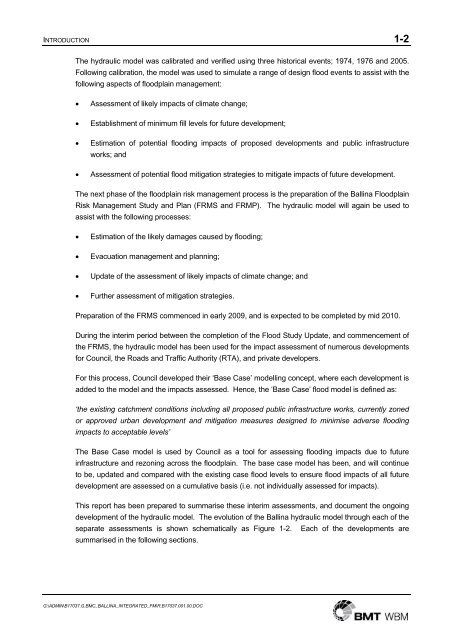Ballina Integrated Flood Modelling Summary of Flood Assessments ...
Ballina Integrated Flood Modelling Summary of Flood Assessments ...
Ballina Integrated Flood Modelling Summary of Flood Assessments ...
- No tags were found...
You also want an ePaper? Increase the reach of your titles
YUMPU automatically turns print PDFs into web optimized ePapers that Google loves.
INTRODUCTION 1-2<br />
The hydraulic model was calibrated and verified using three historical events; 1974, 1976 and 2005.<br />
Following calibration, the model was used to simulate a range <strong>of</strong> design flood events to assist with the<br />
following aspects <strong>of</strong> floodplain management:<br />
• Assessment <strong>of</strong> likely impacts <strong>of</strong> climate change;<br />
• Establishment <strong>of</strong> minimum fill levels for future development;<br />
• Estimation <strong>of</strong> potential flooding impacts <strong>of</strong> proposed developments and public infrastructure<br />
works; and<br />
• Assessment <strong>of</strong> potential flood mitigation strategies to mitigate impacts <strong>of</strong> future development.<br />
The next phase <strong>of</strong> the floodplain risk management process is the preparation <strong>of</strong> the <strong>Ballina</strong> <strong>Flood</strong>plain<br />
Risk Management Study and Plan (FRMS and FRMP). The hydraulic model will again be used to<br />
assist with the following processes:<br />
• Estimation <strong>of</strong> the likely damages caused by flooding;<br />
• Evacuation management and planning;<br />
• Update <strong>of</strong> the assessment <strong>of</strong> likely impacts <strong>of</strong> climate change; and<br />
• Further assessment <strong>of</strong> mitigation strategies.<br />
Preparation <strong>of</strong> the FRMS commenced in early 2009, and is expected to be completed by mid 2010.<br />
During the interim period between the completion <strong>of</strong> the <strong>Flood</strong> Study Update, and commencement <strong>of</strong><br />
the FRMS, the hydraulic model has been used for the impact assessment <strong>of</strong> numerous developments<br />
for Council, the Roads and Traffic Authority (RTA), and private developers.<br />
For this process, Council developed their ‘Base Case’ modelling concept, where each development is<br />
added to the model and the impacts assessed. Hence, the ‘Base Case’ flood model is defined as:<br />
‘the existing catchment conditions including all proposed public infrastructure works, currently zoned<br />
or approved urban development and mitigation measures designed to minimise adverse flooding<br />
impacts to acceptable levels’<br />
The Base Case model is used by Council as a tool for assessing flooding impacts due to future<br />
infrastructure and rezoning across the floodplain. The base case model has been, and will continue<br />
to be, updated and compared with the existing case flood levels to ensure flood impacts <strong>of</strong> all future<br />
development are assessed on a cumulative basis (i.e. not individually assessed for impacts).<br />
This report has been prepared to summarise these interim assessments, and document the ongoing<br />
development <strong>of</strong> the hydraulic model. The evolution <strong>of</strong> the <strong>Ballina</strong> hydraulic model through each <strong>of</strong> the<br />
separate assessments is shown schematically as Figure 1-2. Each <strong>of</strong> the developments are<br />
summarised in the following sections.<br />
G:\ADMIN\B17037.G.BMC_BALLINA_INTEGRATED_FM\R.B17037.001.00.DOC


